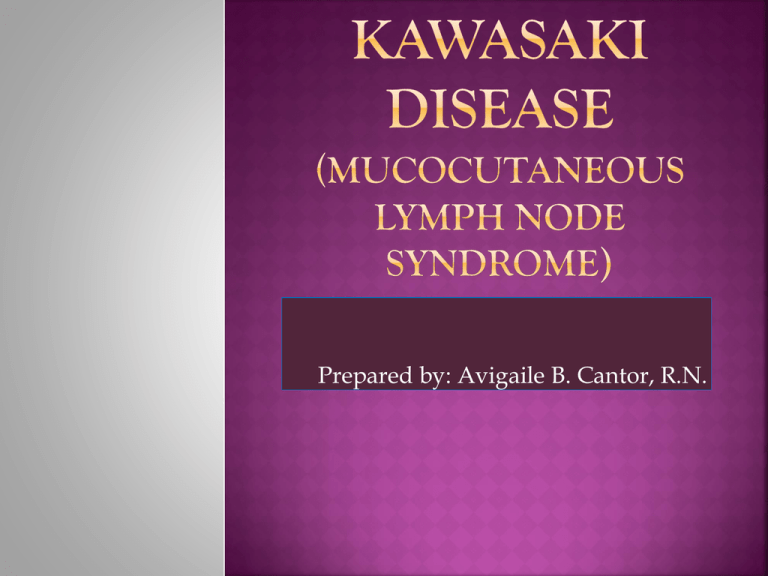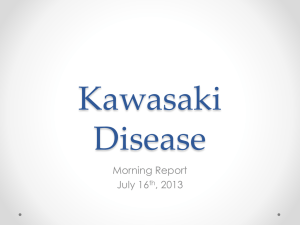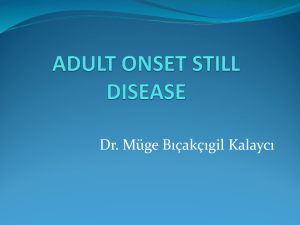
Prepared by: Avigaile B. Cantor, R.N.
no: 165***
Name: Baby Girl A
Age: 2 years old
Sex: Female
Case
Diagnosis:
KAWASAKI
DISEASE
●
GENERAL ASSESSMENT
Patient
looks weak, pale and febrile.
She is conscious and oriented.
VITAL
RR
SIGNS
= 26/ min
PR= 130bpm
T=39*C
SPo2= 98 %
SKIN
Pale
in appearance
Warm to touch
Slightly dehydrated
Poor skin turgor
Erythematous maculopapular rashes noted
HEAD
and NECK
No deformities found.
Left lymph node ( 1 x1 cm)
•GASTROINTESTINAL TRACT
No palpable masses
•MUSCULOSKELETAL
Moderately active, moving freely; ambulatory
The
patient has family history of asthma.
PREVIOUS SURGERY
No
history of surgery.
A
2 years old, female patient brought to
OPD- PEDIA with mother chief
complaint of fever, sore throat since 10
days. Patient receiving antibiotic 7 days
with no improvement. Skin rashes since
5 days.
Unobtainable
History.
IMMUNIZATION SCHEDULE
Unobtainable
History.
INTRODUCTION
What
is KAWASKI DISEASE?
( MUCOCUTANEOUS LYMPH NODE SYNDROME)
“ A Self limited vasculitis of unknown etiology that
predominantly affects children younger than 5 years. It
is now the most common cause of acquired heart
disease in children in the United States and Japan.”
Jane Burns, MD*
Idiopathic multisystem disease chareacterized by
vasculitis of small and medium blood vessels,
including coronary arteries.
Kawasaki
disease is an
illness that involves the skin,
mouth, and lymph nodes, and
most often affects kids under
age 5. The cause is unknown.
SKIN
is a soft outer covering of an animal, in particular a
vertebrate. The adjective cutaneous literally means "of the
skin" (from Latin cutis, skin). In mammals, the skin is the
largest organ of the integumentary system made up of
multiple layers of ectodermal tissue, and guards the
underlying muscles, bones, ligaments and internal
organs. Because it interfaces with the environment, skin
plays a key role in protecting (the body)
against pathogens and excessive water loss. Its other
functions are insulation, temperature regulation,
sensation, and the protection of vitamin B folates.Red
rash usually first seen on the palms and soles that then
spreads to involve the torso within a couple days. The
most common appearance is a hive-like rash; however it
mayalso resemble measles (morbilliform rash), erythemai
multiforme or a scarletina like rash. It is more impressive
on the hands and feet than the torso and the hands and
feet generally develop some swelling as well.
HEART
may be affected in as many as one of five children
who develop Kawasaki disease. Damage sometimes
occurs to the blood vessels that supply the heart
muscle (the coronary arteries) and to the heart
muscle itself. A weakening of a coronary artery can
result in an enlargement or swelling of the blood
vessel wall (an aneurysm). Infants less than 1 year
old are usually the most seriously ill and are at
greatest risk for heart involvement.
TONGUE
Characteristics of strawberry tongue are sloughing
of the filiform papillae(caused by the systemic
inflammatory process) and persistence of the
fungiform papillae,which form the "seeds" of the
strawberry. Strawberry tongue is not specific to
Kawasaki disease; it may also be present in
streptococcal and staphylococcal toxin-mediated
disease.
LYMPH
NODES
Edema is often seen in the hands and feet and the
cervical lymph nodes are often enlarged.
-Experts don't know what causes the disease.
PREDISPOSING FACTORS:
Young
age group ( below 5 years)
Considered to be an autoimmune disease.
Heredity
Environmental facts
Exposure to previous infection
Regardless of the location, Japanese children
are more prone to develop this.
Precipitating Factors:
Unknown yet linked with unknown etiologic
agent and environmental factors
Predisposing factors:
Age-1 year old
Sex-Male
Race-Asian
S/S:
A fever lasting at least 5 days.
Red eyes.
A body rash.
Swollen, red, cracked lips and tongue.
Swollen, red feet and hands.
Swollen lymph nodes in the neck.
If treated:
Discharge the
patient
DEATH
Myocardial
infarction
Autoimmune
response
Good
prognosis
If not treated:
Complications developed
Pericarditis,Myocarditis,
Cardiomegaly,Coronary
artery aneurysm
Persistent fever between 102 °F up to 104 °F
Classic sign is persistent fever that may last for 5 days
Fever does not improve even with antipyretic medications
Red eyes without any discharges
Cracked and red lips
Red buccal mucosa
Strawberry tongue, white spots with bumps can be seen
also
Palmar and planter redness.
Joint swelling
Lymphadenopathy
Skin rashes that is evident in the middle part of the body
Irritability and inability to sleep
Abdominal pain
Acute
( 1-2 weeks from onset)
Febrile,
irritable
Oral changes, rash. Erythema of feet
Subacute
(2-8 weeks from onset)
desquamation
gradual improvement even without treatment
Convalescent
( Months to years later)
CODE
Patient Results
Normal Range
WBC
8.54
3.98-10.04
RBC
3.9 (10^6/UL)
3.93-5.22
HGB
10.6 (G/DL)
11.2-15.7
HCT
34.2(%)
34.1-44.9
PLT
967(10^/UL
182-369
C-Reactive Protein
(CRP)
POSITIVE ( 24
mg/L
Negative
ESR
89 mm in 1st hr
0-20
There is no known specific test for Kawasaki disease.
CBC- increased platelet count.
Erythrocyte sedimentation rate(ESR)
C-reactive protein(CRP)
Chest x-rays- revealed NORMAL
ECG- No Ischemia, WNL.
Echocardiogram – revealed NORMAL, NORMAL
coronary arteries.
Echocardiogram and electrocardiogram
can also check the valves and other parts of
the heart that may signal an infection. It
may also indicate myocarditis, pericarditis
or any inflammation of the heart.
•Aspirin
to help to reduce pain and fever and to lower the risk
of blood clots.
•Aspirin
has been used to reduce inflammation and to inhibit
platelet aggregation in children with Kawasaki disease.
Immunoglobulin (IVIG) medicine. This is
given through a vein (intravenous, or IV) to
reduce inflammation of the blood vessels.
COMPLICATIONS
Renal
failure
Renal insufficiency
DM
OF IVIG:
DRUG
ROUTE/DOSE/FREQ
UENCY
ACTION
Aspirin
P.O / 80-100 mg /every
6 hours
Drug may relieve fever
through central action
in the hypothalamic
heat- regulating center.
IV Immune globulin
I.V/ 22 g/ every 12 hours Provides passive
immunity by increasing
antibody titer. The
primary component is
IgG. Its unknown how
it works for idiopathic
thrombocytopenic
purpura.
Admission
to the nearest hospital must be
warranted.
Intravenous fluids should be instituted in order
to prevent further dehydration.
The standard treatment involves a prevention of
serious cardiac complications with the use of
intravenous gamma globulin.
Aspirin is used as a complementary dose with IV
gamma globulin.
Monitor the vital signs every hour.
Note the persistence of fever and refer to the
physician.
Instruct the mother to do tepid sponge bath.
Encourage increase of fluid intake if patient is not
vomiting.
Provide comfortable clothes for the child.
Alley the fears and hopes of the family.
Observe proper hand washing before and after
each nursing procedure in order to prevent
further infection.
Administer medication as per Doctor regimen.
1.Acute pain related to sore throat and joint pain.
2. Fever altered body temperature m/b T= 101.8F103.2F.
3.Conjunctivitis L & R eye redness. ( This is the
evidence).
4.Rash Impaired Skin Integrity at bilateral hands M/B
red rash
5. Joint inflammation pain m/b warmth, redness and
swelling.
ASSESSMENT
PLANNING
INTERVENTION
EVALUATION
CUES/
EVIDENCE
GOALS AND DESIRED
OUT COME
NURSING
INTERVENTI
ONS
After 6-8 hours of
nursing
interventions the
goals were met as
evidenced by:
SUBJECTIVE:
“ Mother
complaints
that her child
having fever
since 10 days,”
OBJECTIVE:
Increased in
body
temperature
above normal
range
flushed
skin,
warm to
touch
increased RR,
T= 39*C
RR= 26bpm
PR=130bpm
NURSING
DIAGNOSI
S
Altered
body
temperatu
re related
to
infection/
inflammat
ion
After 6-8 hours of
nursing intervention
the patient will be able
to maintain core
temperature within
normal range.
*monitor
vital signs
*Monitor
core
temperature
RATIONALE
*to know the
baseline data
*to evaluate
effects degree
of
hyperthermia
*demonstrate
temperature within
normal range from
39*C -36.9*C.
*good skin turgor
*Provide
tepid sponge
bath as
necessary
Dependent:
*Administer
ed
paracetamol
as ordered
Dose: 5ml
Route: P.O
Frequency:
every 4-6
hours
*To reduce
body
temperature
* To reduce
inflammation
and pain.
*VS stable:
BP= 90/60
T= 36.9*C
RR=23bpm
PR=120bpm
ASSESSMENT
Cues/Evidence
SUBJECTIVE
“ mother
complaints
that there is
skin rash for 5
days.
OBJECTIVE:
•Pale in
appearance
•Warm to
touch
Slightly
dehydrated
•Poor skin
turgor
•Erythematous
maculopapular
rashes noted
T-39*C
RR-26 bpm
PLANNING
Nursing
Diagnosis
Impaired Skin
integrity
Related to
inflammatory
process as
evidenced by
disruption
of skin
surfaces,
macular rash
and skin
desquamation
INTERVENTION
Nursing
Interventio
n
After 3 days of nursing
interventions, the client
will be able to:
1. Display timely healing
of rash and
skin desquamation
2. Maintain optimal
nutrition.
Independe
nt:
*Periodical
ly re
measure/
photograph
wound and
observe
for complic
ations.
Rationale
*to monitor
progress
of wound
healing
*Keep the
area
clean/dry,
carefully
*to assist
body’s
natural proces
s of repair
Collaborat
ive:
*Applicatio
n of antiitch
ointment.
*to prevent
irritation and
relieve skin
itchiness.
*Administe
r hydroxyzi
ne as
ordered
EVALUATION
*to
decreaseinfla
mmation
After 3 days of nursing
interventions:Goal met:
the client has able to
exhibit optimum healing
of rashes and skin
desquamation.
The client has able to eat
regularly 3 times a day.
1.Encouraged
the mother for the proper diet of
the child.
2.Advice in regards to a heart-healthy diet.
3.Advice the mother to do physical care for her
child.
4.Instructed the mother to observe signs of the
disease.
5. Explained to the mother the importance of
follow up care.
6.Emphasized the importance of take home
medications prescribed by the physician.
It
may be a few weeks before your child feels
completely well. But most children with Kawasaki
disease get better and have no long-term
problems. Early treatment is important because it
shortens the illness and lowers the chances of
heart problems. Follow-up tests can help you and
your doctor be sure that the disease did not cause
any serious problems. If your child is affected,
know what to watch for and when to seek care.
Nelson
textbook of Pediatrics
www.webmd.com/heart-disease/tc/kawasakidisease en.wikipedia.org/wiki/Kawasaki_disease
rnspeak.com › Maternal & Child Nursing
END OF
PRESENTATION








![Mistry-VisualDiagnosis12-5-07[2]](http://s2.studylib.net/store/data/005753399_1-f3c8e8f06b6b9b9f31dbd547ba21de96-300x300.png)



